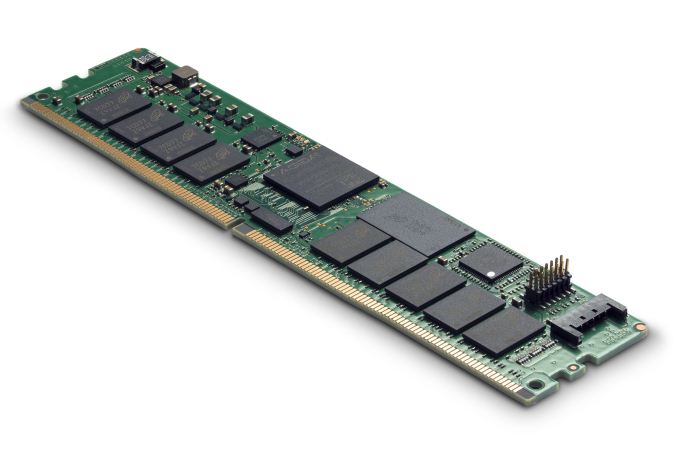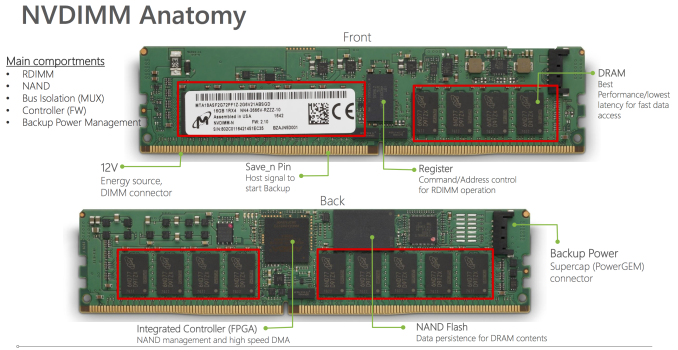Micron Announces 32GB DDR4 NVDIMM-N Modules
by Billy Tallis on November 13, 2017 9:00 AM EST
Micron is announcing today their next generation of NVDIMM-N modules combining DDR4 DRAM with NAND flash memory to support persistent memory usage models. The new 32GB modules double the capacity of Micron's previous NVDIMMs and boost the speed rating to DDR4-2933 CL21, faster than what current server platforms support.
Micron is not new to the Non-Volatile DIMM market: their first DDR3 NVDIMMs predated JEDEC standardization. The new 32GB modules were preceded by 8GB and 16GB DDR4 NVDIMMs. Micron's NVDIMMs are type N, meaning they function as ordinary ECC DRAM DIMMs but have NAND flash to backup data to in the event of a power loss. This is in contrast to the NVDIMM-F type that offers pure flash storage. During normal system operation, Micron's NVDIMMs use only the DRAM. When the system experiences a power failure or signals that one is imminent, the module's onboard FPGA-based takes over to manage saving the contents of the DRAM to the module's 64GB of SLC NAND flash. During a power failure, the module can be powered either through a cable to an external AGIGA PowerGEM capacitor module, or by battery backup supplied through the DIMM slot's 12V pins.
Micron says the most common use cases for their NVDIMMs are for high-performance journalling and log storage for databases and filesystems. In these applications, a 2S server will typically be equipped with a total of about 64GB of NVDIMMs, so the new Micron 32GB modules allow these systems to use just a single NVDIMM per CPU, leaving more slots free for traditional RDIMMs. Both operating systems and applications need special support for persistent memory provided by NVDIMMs: the OS to handle restoring saved state after a power failure, and applications to manage what portions of their memory should be allocated from the persistent portion of the overall memory pool. This can be addressed either through applications using block storage APIs to access the NVDIMM's memory, or through direct memory mapping.
Micron is currently sampling the new 32GB NVDIMMs but did not state when they will be available in volume.
Conspicuously absent from Micron's announcement today is any mention of the third kind of memory they make: 3D XPoint non-volatile memory. Micron will eventually be putting 3D XPoint memory onto DIMMs and into SSDs under their QuantX brand, but so far they have been lagging far behind Intel in announcing and shipping specific products. NVDIMMs based on 3D XPoint memory may not match the performance of DRAM modules or these NVDIMM-N modules, but they will offer higher storage density at a much lower cost and without the hassle of external batteries or capacitor banks. Until those are ready, Micron is smart to nurture the NVDIMM ecosystem with their DRAM+flash solutions.
Source: Micron











48 Comments
View All Comments
Hereiam2005 - Tuesday, November 14, 2017 - link
Fpga consumes far less power than any off the shelf CPU for what it can do.Which is offering huge bandwidth. A basic virtex fpga is capable of handling 300gbps+ bandwidth within a several watts power envelope - nothing off the shelf can come close.
Of course they could make an asic to the same spec, but that will delay the time to market of the product.
Elstar - Monday, November 13, 2017 - link
The people who buying these DIMMs think that the tradeoffs are well worth it.As the article points out, the primary customers are transaction heavy workloads. When RAM becomes nonvolatile, then the number of transactions per second can go up dramatically.
ddriver - Monday, November 13, 2017 - link
"When RAM becomes nonvolatile, then the number of transactions per second can go up dramatically."Now all that remains do be done is to explain how does this statement relate to this product. Because that's still 100% volatile ram, and having it being dumped on flash storage in no way changes its nature or performance. And you don't really need any of that to accomplish said goal. You can just as easily dump paged memory to a pcie drive, without any need to increase cost or complexity.
ddriver - Monday, November 13, 2017 - link
And if you go for actually persistent solution rather than "dump on power loss, restore on power on" you will absolutely massacre performance as well as the poor flash memory as well.Actually persistent solution would mirror every memory operation on the flash memory, and while SLC flash is very fast, it is tremendously slower than dram, and that will destroy performance, not to mention completely defeat the purpose of having dram in the first place.
It will be even worse in terms of rapidly wearing the flash memory, because ram writes are often very small - ram is byte addressable, which will lead to tremendous write amplification, horribly worse than what you see from the file system. Even with SLC memory, that module won't last a week of typical use.
Which is exactly why they didn't go for a true non-volatile solution but a simple dump-restore mechanism, which minimizes nand usage, doesn't butcher performance and doesn't eat through the flash p/e cycles in record time.
Elstar - Monday, November 13, 2017 - link
I think you're overthinking this. Servers are the target market here, and power outages and shutdowns should be rare; and therefore "dump and restore" is good enough. In fact, some of these DIMMs might never experience a single "dump and restore" operation in their lifetime. They'll be plugged in, powered on, and they'll be lucky enough to continuous power until decommissioning.Elstar - Monday, November 13, 2017 - link
Ensuring that data is committed to NVRAM takes maybe a couple hundred nanoseconds (via a few cache flushing synchronization instructions). On the other hand, ensuring that data is committed to NVMe requires many microseconds, if not milliseconds worth of OS system calls. In other words, orders of magnitude slower. Sure, one can try and batch transactions to minimize the cost of NVMe I/O, but at that point, the latency of pending transactions starts to skyrocket, and one still cannot overcome the fact that CPU-to-RAM bandwidth is much higher than PCIe bandwidth.Finally, one could buy a large UPS to provide backup power to the whole machine while the in-volatile-memory database/filesystem is backed to during a power outage. But at that point, the added cost and complexity of NVDIMMs start to look better than the added cost and complexity of a large UPS setup.
In short, these are all just tradeoffs, and for some, NVDIMMs are worth it.
PS – I strongly bet that NVDIMMs are effectively hidden during boot. Otherwise the OS might use them for random needs. Once the OS is up and running, then a tiny driver probably tells the NVDIMM to repopulate the onboard RAM from flash, and then a mapping is assigned to the RAM. From there, a database/filesystem can then assign the mapping to their own address space at launch and resume as if nothing happened.
ddriver - Monday, November 13, 2017 - link
This is not non-volatile memory, how is this not obvious by now? Paged memory is saved on the flash upon power loss, which will likely take significantly more than "maybe a couple hundred nanoseconds" or even "many microseconds". You are copying potential gigabytes to a single flash chip, meaning it will not be anywhere nearly as fast as multi-channel nvme drives. It will likely take many seconds, likely more than it would take to dump the memory to a fast pcie drive.Now if they used reram or mram or something that is actually non-volatile and fast, enduring and addressable enough it would be a completely different thing. Then it would make sense. This however doesn't. That being said, nonsense doesn't prevent some people from buying it nonetheless. Some people buy golden toilets encrusted with diamonds. That doesn't mean having golden toilets encrusted with diamonds somehow makes a better cr@pper.
Elstar - Monday, November 13, 2017 - link
Yes, how one defines "non-volatile memory" is certainly contextual and debatable. For some, the Micron approach is good enough.And yes, the dump-and-restore will be slow, but the target market doesn't care because they hope that it will never be necessary, and the upsides of this design are still worth it.
ddriver - Monday, November 13, 2017 - link
So they will pay extra for a feature that is unnecessary to begin with, with the hope that it will never be necessary?That's totally the industry as we know it. And I am not being sarcastic here, not one bit. I am not sarcastic about not being sarcastic either.
Elstar - Monday, November 13, 2017 - link
I give up. George Carlin was right: "Never argue with an idiot. They will only bring you down to their level and beat you with experience."